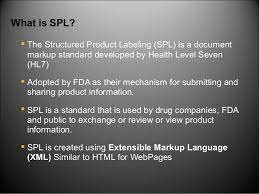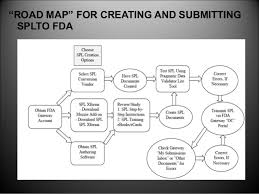The eLeaflet solution by myHealthbox is now supporting the SPL data format thus allowing full compatibility with the FDA digital information format for medicines and healthcare products information.

What is the SPL
The Structured Product Labeling (SPL) is a document markup standard approved by Health Level Seven (HL7 ) and adopted by the FDA as a mechanism for exchanging product and facility information.

Structured Product Labeling (SPL) is a Health Level Seven (HL7) standard based on Clinical Document Architecture and HL7 Reference Information Model (RIM) accredited by the American National Standards Institute (ANSI) for the exchange of product information. Structured Product Labeling documents include a header and body. The header includes information about the document such as the type of product, author and versioning. The body of the document includes product information in both structured text and data element formats. The United States Food and Drug Administration (FDA) uses SPL documents to exchange information covering a growing number of product related topics.
What does this mean ?
Quite simply it is now possible to import FDA registered products in SPL format directly into our eLeaflet platform thus making the creation of an eLeaflet from a product with an SPL data file easy and fully automatic.
What is the difference between eLeaflet and SPL
First of all it is important to clarify that while sharing many similarities from both a data structure and design perspective the two formats solve 2 very different problems and originated from a different perspective into the broader problem of improving product information in the healthcare via digital solutions.
Both are structured representations of data and specifically of product information data and both are targeted at healthcare products.
Both are XML based.
Interoperability can be achieved between the two formats as our recent support for SPL into the eLeaflet demonstrates.
Now to the differences
The focus of SPL and main motivation for its adoption is on the improvement of the regulatory management cycle (data editing, revision, approval). The idea behind it was as a replacement of the MS Word format which was (and still is) widely used during the marketing authorization process to exchange information between the FDA and the MAH or producer.

On the other hand the focus and main motivation behind the development of the eLeaflet is as a replacement and improvement of the paper leaflet that is usually part of a medicine's packaging. The idea is to improve the experience for the final user (patients or HCPs), improve content accessibility and discovery and open the path to innovative functionalities.
While all the content definition features present in the SPL are also found in the eLeaflet, the latter allows for the definition of dynamic and interactive elements which are missing in the SPL design.
The eLeaflet is also designed for wide distribution and features like content security, digital signatures, notarization, content guarantee and encapsulation are standard features as required by typical pharma-grade solutions that are heavily regulated, accessed by millions of people.
Examples
A few examples of eLeaflets generated from an SPL are available here:
-
[Bactrim](https://myhealthbox.eu/en/bactrim-ds-sulfamethoxazole-and-trimethoprim-tabletbactrim-sulfa/3809056?target=_blank
More information about the eLeaflet solution from myHealthbox is available on the eLeaflet website